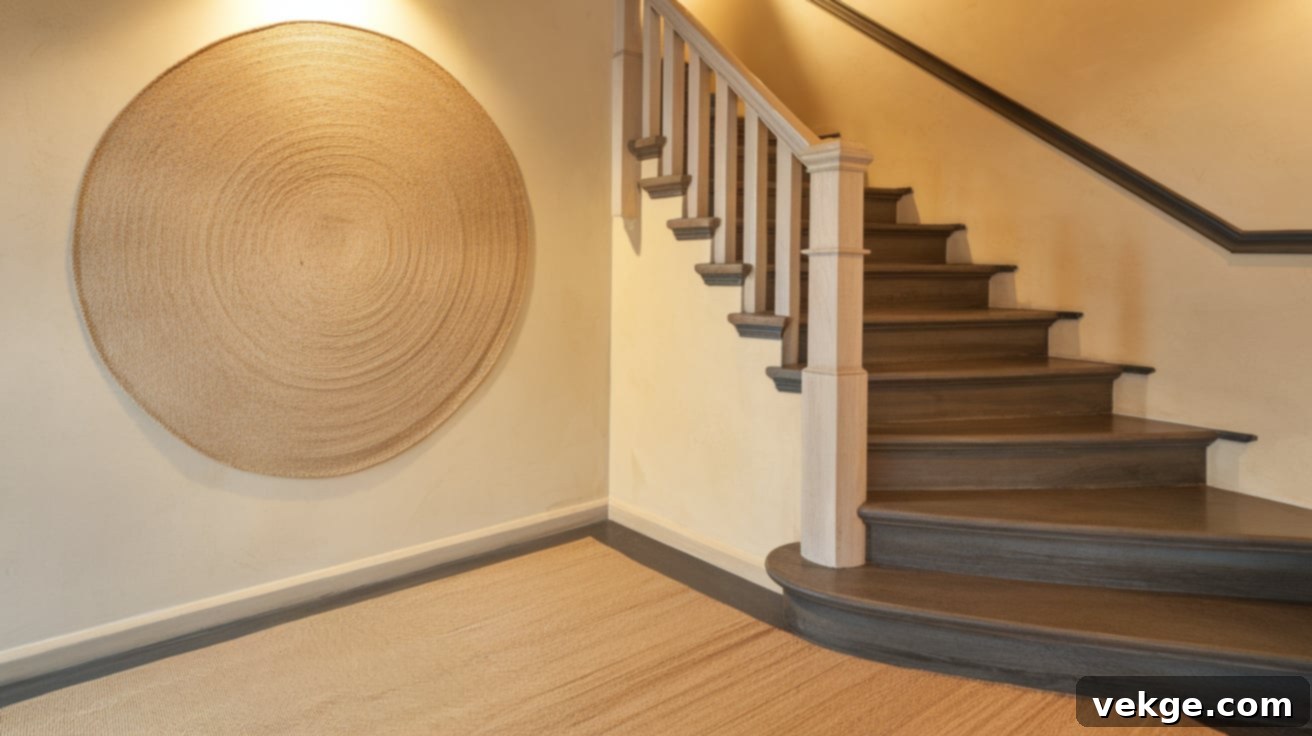The Ultimate Guide to Choosing the Best Paint for Stairs: Durability, Safety, and Style
A well-painted staircase is more than just a functional pathway; it’s a statement piece that can dramatically elevate the aesthetics and atmosphere of your home. I’ve witnessed firsthand the transformative power a fresh coat of paint can have, breathing new life into an entryway and making a striking first impression on anyone who steps through your door.
However, I’ve also learned that the journey to finding the perfect stair paint isn’t always straightforward. It requires careful consideration, as you need a product that not only looks stunning but also possesses the resilience to withstand constant foot traffic, the inevitable scuffs, and the daily wear and tear that stairs endure. Choosing the wrong paint can lead to quick deterioration, frequent touch-ups, and ultimately, disappointment.
That’s where I come in. In this comprehensive guide, I’ll walk you through everything you need to know about selecting the best paints for your stairs. I’ll share my top picks that masterfully combine exceptional durability with timeless style, ensuring your staircase remains beautiful and robust for many years to come.
Prepare to uncover invaluable insights, including:
- The essential factors I meticulously consider when choosing stair paint, focusing on longevity and performance.
- My expert recommendations for a variety of stair materials, from classic wood to modern concrete.
- Proven tips and tricks I’ve refined over countless projects to help you achieve a truly professional, long-lasting finish.
Let’s step up your stair game and transform this often-overlooked area into a captivating focal point in your home.
Why Choosing the Right Stair Paint is Crucial for Your Home
When embarking on any home improvement project, especially one involving a high-traffic area like stairs, I always emphasize that paint selection goes far beyond simply picking a color. It’s a foundational decision that profoundly impacts your home’s safety, the longevity of your staircase, and its overall aesthetic appeal. Skimping on quality or overlooking key characteristics can lead to costly regrets down the line.
Safety First: Preventing Slips and Falls
From my experience, the paint you choose plays a critical role in the safety of your stairs. A slick or worn surface presents a significant hazard, especially in households with children, elderly individuals, or even just busy adults. Slipping on stairs can lead to serious injuries, which is why safety is always my paramount concern.
I actively seek out paints specifically formulated with enhanced traction. Many modern stair paints incorporate special anti-slip additives or a fine grit directly into their composition, providing a subtly textured finish that significantly improves grip. This additional friction can be a game-changer, dramatically reducing the risk of dangerous falls. If you have particularly smooth or polished stairs, or if safety is an extreme priority, you might also consider adding anti-slip tape or rubber treads as an extra layer of protection.
Built to Last: The Importance of Durability
Stairs are arguably one of the most heavily used surfaces in any home. They endure constant foot traffic, the scuffs and scrapes from shoes, the occasional bump from moving furniture, and even dropped objects. I’ve observed that paint on stair treads and risers tends to wear down much faster than on walls or other less-trafficked surfaces.
This is precisely why durability is non-negotiable when I’m selecting a stair paint. I look for formulations engineered to withstand extreme abrasion, chipping, and fading. A robust, long-lasting paint isn’t just about aesthetics; it’s an investment that saves you considerable time, effort, and money in the long run. By choosing a high-quality, durable paint, you significantly extend the period between repainting projects, ensuring your stairs maintain their pristine look and protective qualities for years.
Elevating Aesthetics: Making a Design Statement
While safety and durability are my top practical priorities, I never overlook the immense visual impact a well-painted staircase can have. The right paint color and finish can transform your stairs from a mere utilitarian structure into a captivating architectural feature that enhances your home’s interior design.
The paint you select sets the entire tone for your staircase. Whether you envision a classic, rich wood look, a minimalist modern style, or a vibrant pop of color, the possibilities are endless. A thoughtfully chosen paint color can make your entryway feel more welcoming, brighter, or more sophisticated. It can visually expand a small space or add depth and character to a larger area. Ultimately, the aesthetic choice contributes significantly to your home’s overall ambiance and value, making your staircase a true standout feature.
Understanding Paint Finishes for Stairs
The finish of your paint not only dictates its appearance but also its performance and how easy it is to maintain. For stairs, where durability and cleanability are paramount, choosing the correct finish is crucial. Let’s explore the common options:
| Finish Type | Description | Sheen Level | Durability | Best For | Considerations |
|---|---|---|---|---|---|
| Satin Finish | A smooth, subtle sheen that beautifully masks minor surface imperfections. It offers a soft, elegant look. | Low to Medium | Moderate to High | High-traffic areas with some wear, such as residential stairs, where a softer look is desired. | Hides minor flaws better than glossier options but can be slightly harder to clean than semi-gloss or gloss due to its less slick surface. Offers a good balance of durability and aesthetic appeal. |
| Semi-Gloss Finish | Features a noticeable reflectivity, creating a clean and polished appearance. Its smoother surface makes it highly washable. | Medium | High | Areas requiring frequent cleaning and maximum protection against scuffs and stains, ideal for active households. | While very durable and easy to wipe clean, its moderate shine can highlight some surface imperfections. It’s a popular choice for trim, doors, and stairs due to its practical benefits. |
| Gloss Finish | The most reflective finish, providing a mirror-like shine that truly stands out. It’s exceptionally hard and durable. | High | Very High | Surfaces demanding the absolute maximum durability and resistance to wear and tear, such as commercial stairs or highly trafficked residential staircases. | Its high sheen will unforgivingly show every flaw and imperfection on the surface, requiring meticulous preparation. However, it offers unparalleled protection and is the easiest to clean. |
Key Factors to Consider When Choosing Paint for Stairs
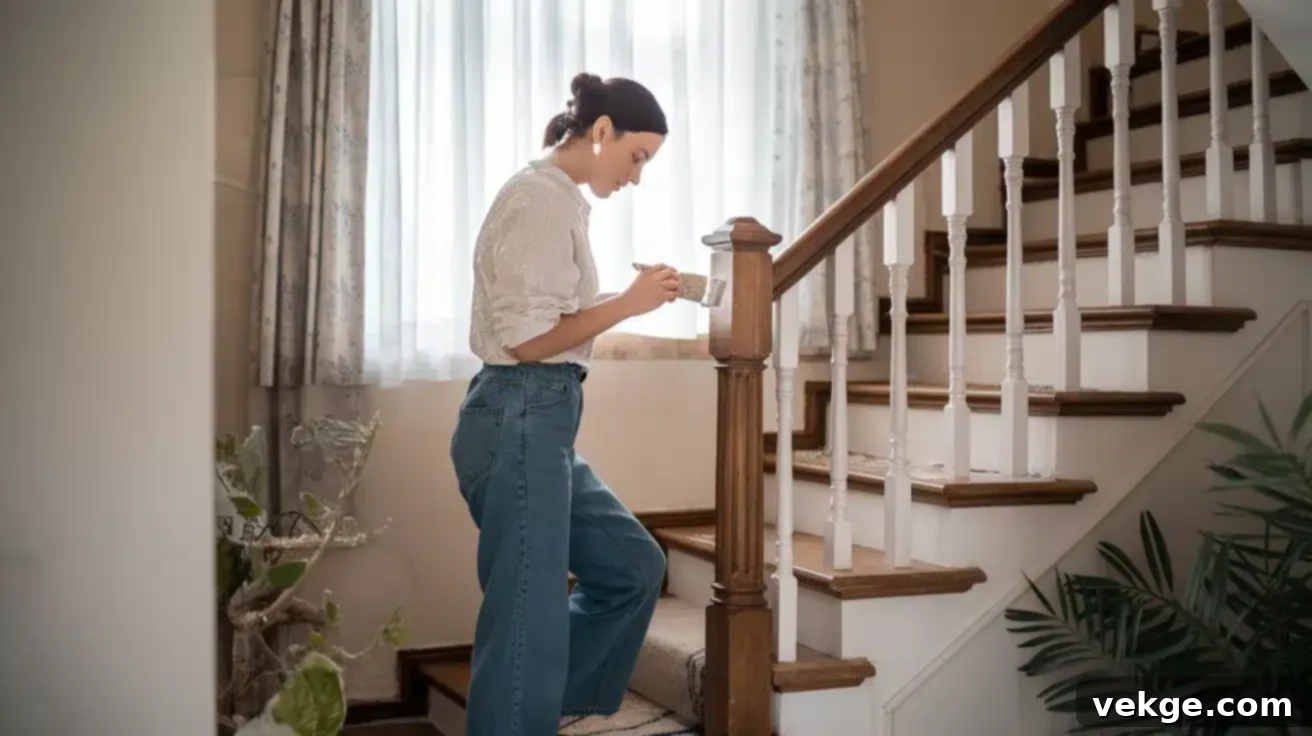
When I’m faced with the task of picking the ideal paint for stairs, I always approach it with a structured mindset, evaluating several critical factors. Let me elaborate on the accumulated wisdom from my past projects and what I’ve learned makes for a truly successful outcome:
1. Uncompromising Durability
I cannot overstate this enough: stairs demand incredibly tough paint. Unlike walls, which only experience occasional bumps, stairs are subjected to relentless impact, abrasion, and friction. I make it a point to specifically look for products marketed as “floor paint,” “porch and patio paint,” or those designed for “high-traffic areas.”
In my extensive experience, paints fortified with urethane or epoxy resins consistently deliver superior performance. These additives significantly enhance the paint’s hardness, flexibility, and resistance to chipping, scuffing, and peeling. While such durable paints might carry a slightly higher upfront cost, viewing it as an investment is key. Spending more on a premium, durable paint ultimately saves me considerable time and money on future touch-ups and repainting efforts, making it a wise long-term decision.
2. Essential Safety Features
My top priority for any stair painting project is always safety. I actively seek out paints that come with inherent anti-slip properties or those that can be easily modified to enhance traction. Some advanced formulations incorporate a fine, gritty aggregate directly into the paint, creating a textured surface that significantly improves grip without compromising aesthetics.
Alternatively, many paint manufacturers offer anti-slip additives that can be mixed into the final coat of paint. These additives are often fine silica or polymer beads that provide added friction. For particularly smooth stair materials or in homes with young children or elderly residents, I might even consider integrating dedicated anti-slip strips or rubber treads onto the stair edges as an additional layer of security. Proper lighting and handrail accessibility also contribute to overall stair safety, complementing your paint choice.
3. Understanding Paint Type: Oil-Based vs. Latex/Acrylic
The fundamental type of paint you choose will impact application, drying time, odor, and final finish. I’ve worked with both oil-based and modern latex/acrylic paints on stairs, and each has its distinct advantages:
- Oil-Based Paints: Traditionally known for their exceptional durability and a smooth, hard-wearing finish. They create a very tough surface that stands up well to heavy wear. However, their primary drawbacks include a much longer drying and curing time, a strong and persistent odor that requires excellent ventilation, and cleanup that necessitates mineral spirits or paint thinner. While excellent for durability, they’ve become less common in residential settings due to these practical considerations.
- Latex/Acrylic Paints: These are my preferred choice for most contemporary stair projects. Modern acrylic-latex formulations have come a long way in terms of durability and performance, often incorporating ceramic or urethane additives for added toughness. They dry significantly faster, have a much lower volatile organic compound (VOC) content and milder odor, and offer the convenience of easy cleanup with just soap and water. Their flexibility also makes them less prone to cracking than older oil-based varieties.
4. Material of Stairs: Tailoring Your Approach
The underlying material of your stairs is a critical determinant in selecting the correct primer and paint system. Different materials have different adhesion requirements and susceptibilities:
- Wood Stairs: The most common type. For wood, meticulous surface preparation (sanding, cleaning) is vital. I always start with a high-quality wood primer to ensure excellent adhesion and a smooth finish. After priming, either an oil-based paint (for maximum hardness) or a high-quality acrylic-latex floor paint (for ease of use and good durability) designed for wood is suitable.
- Concrete Stairs: Often found in basements or outdoor settings, concrete requires specialized paint. I typically opt for epoxy paints, which offer superior durability, chemical resistance, and excellent adhesion to porous concrete. Alternatively, masonry paints formulated to withstand moisture and temperature fluctuations are also good choices. Proper cleaning and possibly acid etching are crucial for optimal adhesion on concrete.
- Metal Stairs: Less common in residential interiors but seen in industrial or modern designs, metal stairs demand specific attention to prevent rust. I always begin with a rust-inhibiting metal primer, followed by an enamel paint specifically formulated for metal surfaces. These paints provide a hard, protective shell that prevents corrosion and stands up to wear.
5. Indoor vs. Outdoor Stairs: Environmental Resilience
The location of your stairs – whether inside or outside – dramatically influences the type of paint you should choose. Paints designed for interior use typically don’t offer the same level of protection against environmental elements as exterior paints:
- Indoor Stairs: For interior stairs, any of the high-durability options discussed above (floor paints, porch and patio paints, enamel paints, or epoxy systems) will perform admirably, provided they are rated for interior high-traffic areas.
- Outdoor Stairs: Exterior stairs face a barrage of challenges: constant UV radiation from the sun, torrential rain, snow, ice, extreme temperature fluctuations, and often mildew growth. For outdoor applications, I exclusively look for paints explicitly labeled for exterior use. These formulations contain special resins and additives that provide enhanced UV resistance (preventing fading and chalking), waterproofing capabilities, and often mildewcides to inhibit fungal growth. Thorough surface preparation and a robust exterior primer are absolutely essential to ensure the paint adheres well and lasts through all seasons.
Which Type of Paint Is Best Suited for Stairs?
Beyond the finish, specific paint types are engineered for the rigorous demands of staircases. Understanding these categories will help you narrow down the best choice for your particular project.
| Paint Type | Description | Durability | Best for | Additional Features |
|---|---|---|---|---|
| Floor Paints | Specifically formulated for high-traffic walking surfaces. These are often acrylic-urethane or epoxy-modified for superior hardness and abrasion resistance. | High to Very High | Indoor stairs, especially residential or light commercial. Excellent for wood or concrete. | Designed to resist scuffs, scratches, and everyday wear. Many are easy to clean and some offer mild anti-slip properties. |
| Porch and Patio Paints | Versatile paints designed to withstand both indoor and outdoor conditions. They offer good weather resistance. | Moderate to High | Outdoor stairs, covered porches, and indoor stairs where enhanced weather/moisture resistance is a plus. | Weather-resistant, tolerant to temperature changes, and often contain mildewcides. Available in a range of finishes and colors. |
| Enamel Paints | Known for creating a hard, smooth, and very durable finish. Often oil-based, but water-based alkyd enamels are also available. | Very High | Wooden and metal stairs, trim, and railings. Provides a protective, often glossy, shell. | Resists wear and tear, chips, and provides a beautiful, often high-sheen, finish that’s easy to wipe clean. |
| Epoxy Paints | A two-part system that cures into an extremely hard, chemical-resistant, and heavy-duty coating. Unparalleled durability. | Exceptional | Concrete garage stairs, basement stairs, or industrial/commercial applications where extreme durability is needed. | Highly resistant to chemicals, stains, oil, and heavy abrasion. Can be slippery if not combined with anti-slip additives. |
| Anti-Slip Paints/Additives | These are either paints with integrated grit or separate additives mixed into standard floor/porch paint to enhance traction. | Varies (depends on base paint) | Any stairs where safety is a primary concern, especially in slippery areas, or for commercial/public access stairs. | Provides a textured surface to significantly improve grip. Can be clear or colored, and the level of grit can vary. |
Top Paint Brands and Products for Painting Stairs (My Recommendations)
Disclaimer: These recommendations are based on my personal experience and research into product performance. None of the products mentioned are affiliated or sponsored, and I encourage you to always read product labels for specific application instructions and safety information.
1. KILZ Interior/Exterior Enamel Porch & Patio Latex Floor Paint
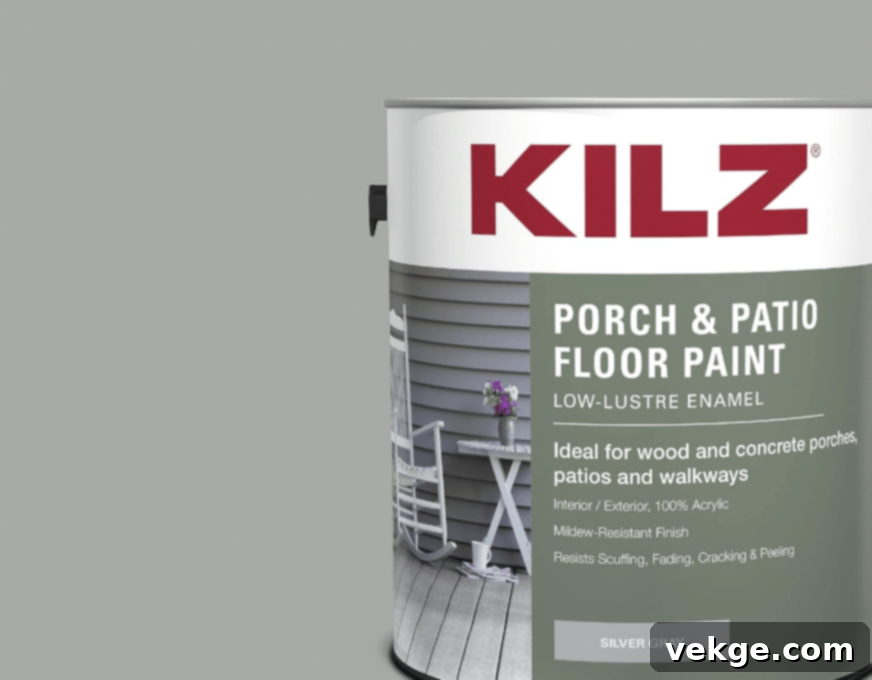
KILZ is a trusted name, and this versatile paint lives up to the reputation. It’s an excellent choice for both indoor and outdoor stairs, offering a durable, mildew-resistant finish that holds up remarkably well in high-traffic areas. Its low-luster enamel provides a subtle sheen that hides imperfections while being easy to clean.
- Type of Paint: Acrylic latex
- Finish: Low-luster enamel
- Best Colors in the Range: Slate Gray, Silver Gray, and Brick Red – classic choices that offer great versatility.
2. Behr Premium Porch & Patio Floor Paint
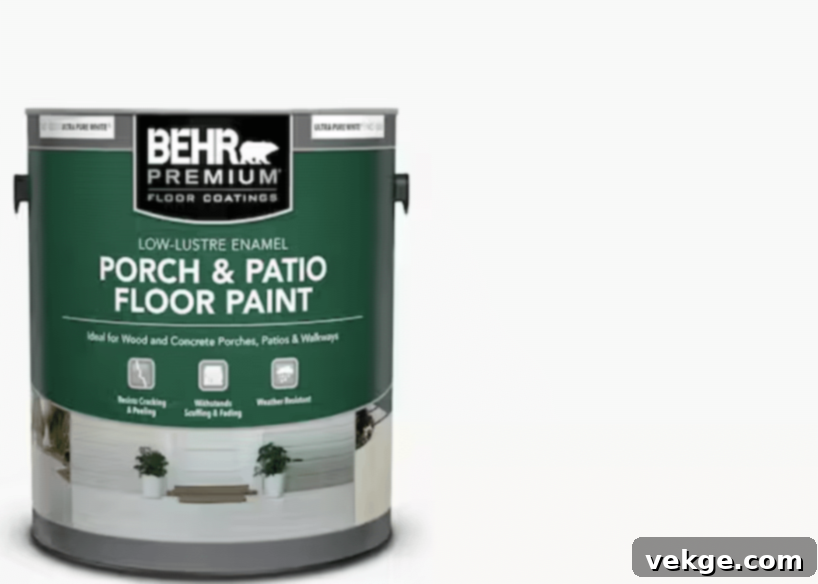
Behr Premium Porch & Patio paint is designed with durability in mind, making it a fantastic option for staircases that see heavy use. Its scuff-resistant formula ensures a long-lasting finish on various surfaces, including wood and concrete patios and stairs. It’s easy to apply and offers excellent coverage.
- Type of Paint: Water-based acrylic
- Finish: Low-sheen
- Best Colors in the Range: Slate Gray, Dark Gray, and Tile Red – providing robust, attractive options for a range of home styles.
3. Benjamin Moore ADVANCE
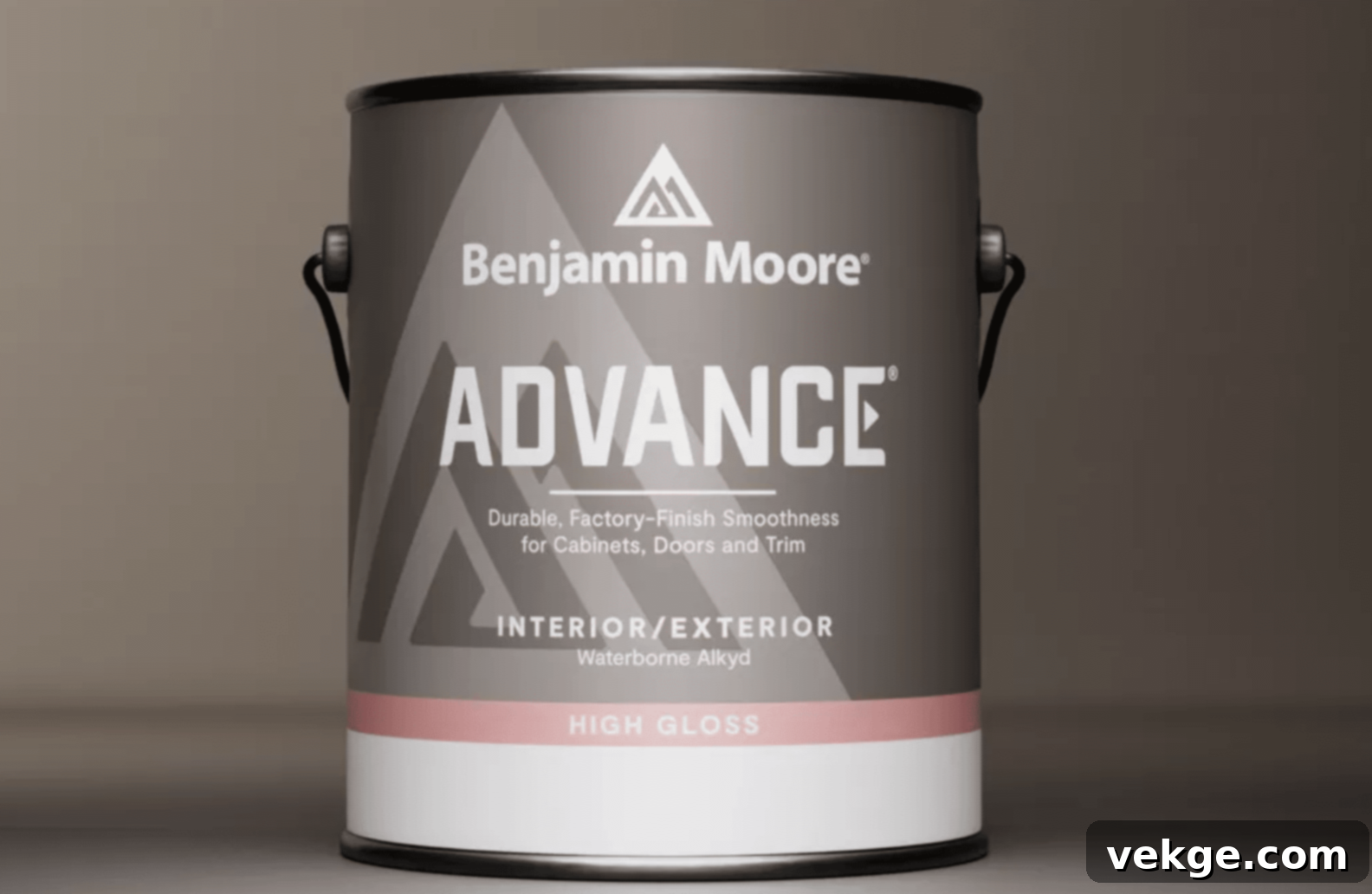
While often recommended for cabinetry and trim, Benjamin Moore ADVANCE is an excellent choice for stair risers, spindles, and railings due to its exceptional hard, furniture-like finish. This water-based alkyd paint flows on smoothly, minimizing brush marks and creating a beautiful, durable surface that withstands daily handling and cleaning.
- Type of Paint: Water-based alkyd
- Finish: Satin or high-gloss
- Best Colors in the Range: White Dove, Cloud White, and Kendall Charcoal – timeless, elegant shades perfect for a sophisticated staircase.
4. Benjamin Moore Floor & Patio

Another strong contender from Benjamin Moore, their Floor & Patio paint is specifically formulated for high-traffic surfaces like stair treads. This acrylic latex paint provides a robust, peel- and crack-resistant finish with excellent coverage, making it a reliable choice for long-lasting stair protection.
- Type of Paint: Acrylic latex
- Finish: Low-sheen or gloss
- Best Colors in the Range: Battleship Gray, Tile Red, and Oxford Gray – versatile and classic colors that offer excellent hiding power.
5. Rust-Oleum Interior Floor Coating Kit

For ultimate durability on concrete or heavily used wooden stairs, the Rust-Oleum Interior Floor Coating Kit is a fantastic option. This two-step epoxy system, comprising a base coat and a durable topcoat, cures to an incredibly strong, long-lasting finish that resists abrasion, chemicals, and hot tire pickup (if used on a garage floor section). It’s an excellent choice for basement stairs.
- Type of Paint: Epoxy floor coating
- Finish: Satin
- Best Colors in the Range: Gray, Tan, and Silver – practical, industrial-strength colors that offer robust performance.
6. INSL-X Sure Step Acrylic Anti-Slip Coating
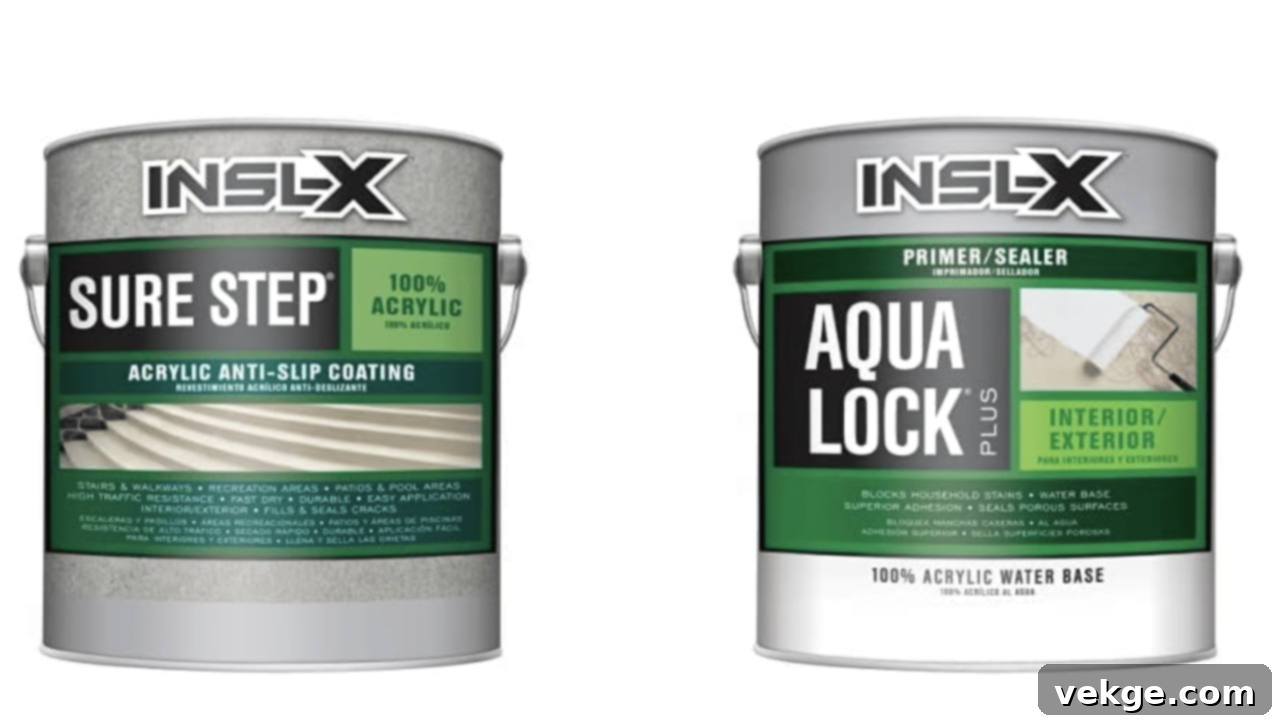
When safety is paramount, INSL-X Sure Step is a top-tier choice. This coating is specifically formulated to provide a durable, slip-resistant surface, making it an incredibly safe option for both indoor and outdoor stairs. It integrates a fine aggregate that offers excellent traction without feeling overly rough underfoot.
- Type of Paint: Acrylic anti-slip
- Finish: Textured
- Best Colors in the Range: Gray Pearl, Tile Red, and Saddle Brown – practical colors designed to integrate well while providing maximum safety.
7. Sherwin-Williams All Surface Enamel
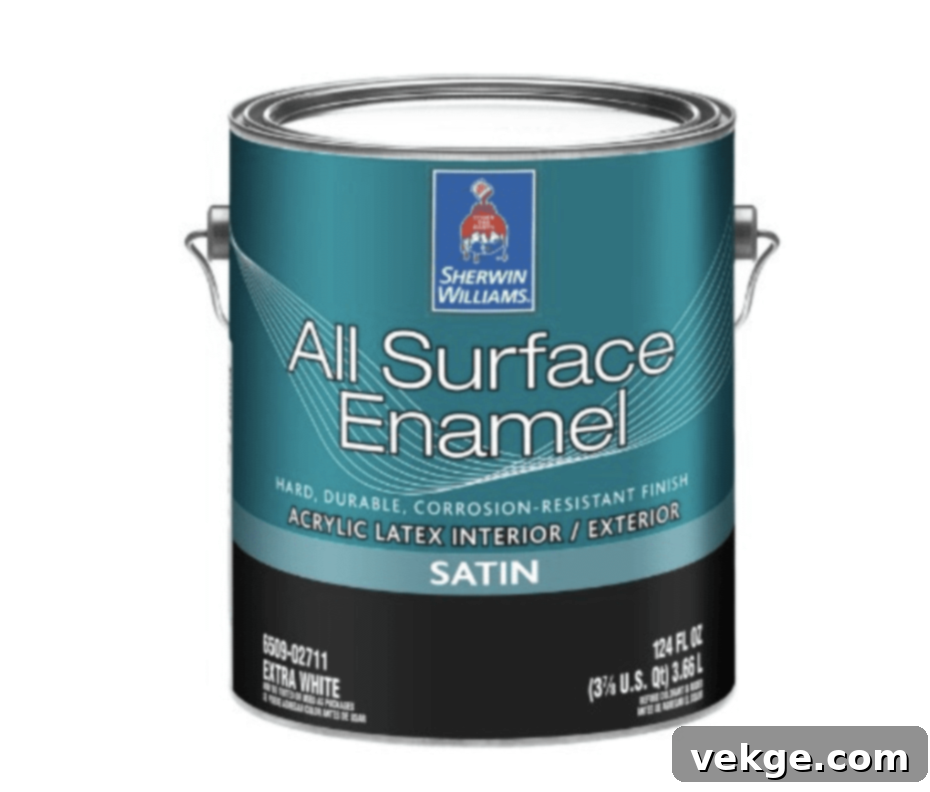
Sherwin-Williams All Surface Enamel, particularly the oil-based version, is a workhorse paint suitable for a multitude of surfaces, including stair components like railings, newel posts, and even treads (with proper preparation). It offers a hard, glossy or satin finish that is highly resistant to scuffs and scratches, providing exceptional durability.
- Type of Paint: Oil-based enamel
- Finish: Glossy or satin
- Best Colors in the Range: Extra White, Black, and Dover White – classic, versatile colors that provide crisp lines and a durable finish.
8. Diamond Brite Oil-Based Enamel
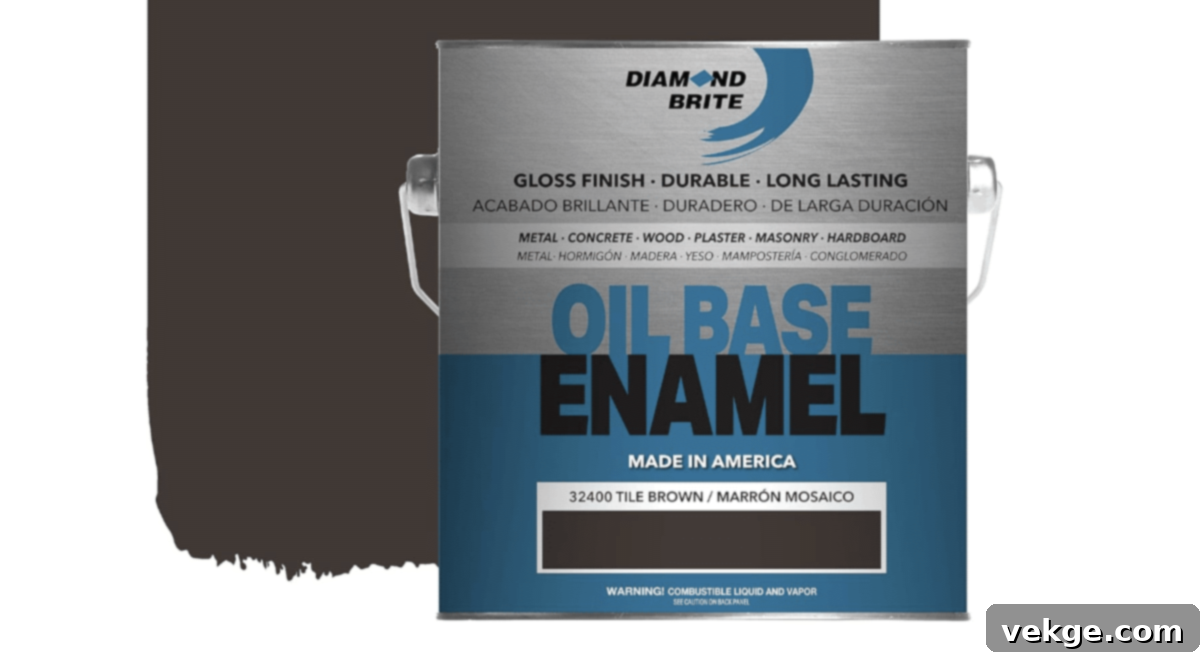
Diamond Brite’s Oil-Based Enamel is another excellent option for areas requiring extreme toughness. This paint is specifically formulated to withstand harsh conditions, creating a water-resistant and hard-wearing finish. It’s particularly ideal for metal and wooden stairs that demand maximum protection and a high-gloss, easily cleanable surface.
- Type of Paint: Oil-based enamel
- Finish: Glossy
- Best Colors in the Range: Black, White, and Safety Yellow – offering bold, high-visibility, and industrial-strength color options.
9. Valspar Porch, Floor, and Patio Latex Paint

Valspar’s Porch, Floor, and Patio Latex Paint offers a balanced blend of great coverage and impressive durability. Its acrylic latex formula is both weather-resistant and scuff-resistant, making it a versatile and reliable choice for both indoor and outdoor stair surfaces, delivering a long-lasting and attractive finish.
- Type of Paint: Acrylic latex
- Finish: Low-luster
- Best Colors in the Range: Light Gray, Tile Red, and White – providing fresh, clean, and adaptable color options.
Expert Tips for Painting Stairs Like a Pro
Having painted my fair share of staircases over the years, I’ve accumulated a wealth of practical knowledge and effective tricks. Allow me to share these expert tips to ensure your stair-painting project is not only successful but also yields a beautiful, professional, and lasting finish.
Mastering Strategic Workflow
Painting stairs can disrupt your home’s functionality, so I always employ a strategic approach. My go-to method is to paint every other step, starting from the top. This clever technique allows you to continue using the staircase, stepping only on the unpainted steps, while the freshly coated steps dry thoroughly. Once the first set of steps is completely dry and cured (which can take 24-48 hours depending on the paint and humidity), I then return to paint the remaining steps. For spiral stairs, I recommend working your way down, tackling the outer edges and risers first, then moving to the treads. Always plan your exit route!
Prioritizing Safety Precautions
Safety should never be an afterthought. For the final coat on treads, I often mix non-slip additives directly into the paint, creating a subtle textured finish that significantly improves grip. These additives are usually fine, clear granules that don’t visibly alter the paint color. In high-traffic areas, or in homes with young children or elderly residents, I frequently recommend applying anti-slip tape or strips directly to the front edge of each step after the paint has fully cured. This provides an extra layer of security, especially for polished or glossy finishes. Ensure proper ventilation throughout the painting process, especially if using oil-based paints, by opening windows and using fans.
Thorough Surface Preparation is Non-Negotiable
A flawless finish begins with meticulous surface preparation. I always start by thoroughly cleaning the stairs, removing all dirt, grime, and grease. For wooden stairs, this often involves sanding to create a smooth, even surface and to ensure proper paint adhesion. Repair any cracks, holes, or imperfections with wood filler and sand smooth. For concrete, a degreaser and possibly an acid etch might be necessary. Metal stairs will need rust removal and a thorough wipe-down. Proper preparation eliminates common painting failures like peeling and poor adhesion.
The Indispensable Role of Primer
Never skip the primer! Applying a high-quality primer is a critical step I never overlook. Primer creates a uniform base for your topcoat, enhances paint adhesion, blocks stains, and ensures a more vibrant, consistent color. For wooden stairs, an appropriate wood primer is essential. For metal, a rust-inhibiting primer is a must. On previously painted stairs, a bonding primer can improve adhesion, especially if you’re switching paint types or colors. Primer makes your final paint job more durable and professional-looking.
Protecting Surrounding Areas Diligently
Before any paint touches the brush, I dedicate ample time to protecting adjacent surfaces. I use high-quality painter’s tape to meticulously mask off baseboards, walls, carpet edges, and any unpainted stair components like railings or newel posts that aren’t getting a fresh coat. Laying down drop cloths at the bottom and top of the stairs, as well as on any nearby flooring, is crucial. This preemptive protection is far easier and less time-consuming than trying to clean up accidental paint splatters later on.
Mindful Maintenance for Longevity
Once your stairs are beautifully painted, thoughtful maintenance is key to preserving their fresh look. I advise regular sweeping or vacuuming to remove abrasive grit and dirt. For deeper cleaning, a damp mop with a mild, non-abrasive household cleaner is usually sufficient. Avoid harsh chemicals, as these can dull the finish or even damage the paint over time. I also make it a habit to promptly touch up any chips or scuffs as they appear, preventing further deterioration. For high-traffic areas, a full repaint every few years might be necessary to keep your stairs looking impeccable.
Wrapping It Up: Your Path to Beautiful, Durable Stairs
As we conclude, it’s clear that choosing the right paint for your stairs is far more than a simple aesthetic decision—it’s about creating a safe, highly durable, and undeniably attractive focal point in your home. I’ve guided you through the critical considerations, from the inherent safety features of anti-slip paints to the impressive longevity offered by high-performance finishes like epoxy and acrylic-urethane formulations. You now understand why meticulous preparation, the right paint type for your material, and smart application techniques are paramount to a lasting result.
I’ve also shared my curated list of top-performing paints from leading brands, each capable of handling the daily grind of foot traffic while maintaining a beautiful appearance. Remember, the true art of painting stairs lies in balancing uncompromising durability with essential safety and captivating style. Whether you’re working with classic wooden treads, robust concrete steps, or sleek metal risers, there is a perfect paint system tailored to your specific project needs.
Now, equipped with these insights and my expert tips, it’s your turn to embark on this transformative journey. Don’t be afraid to unleash your creativity in selecting colors and finishes, but always, always prioritize safety and longevity. A well-painted staircase doesn’t just look good; it functions perfectly and stands the test of time, adding enduring value to your home.
And if you have any inspiring stair painting stories, innovative techniques, or additional tips you’ve discovered along the way, I would absolutely love to hear them! Please share your experiences in the comments section below—your insights could be invaluable to other readers.
Happy painting, and may your freshly painted stairs be both stunning and secure!
